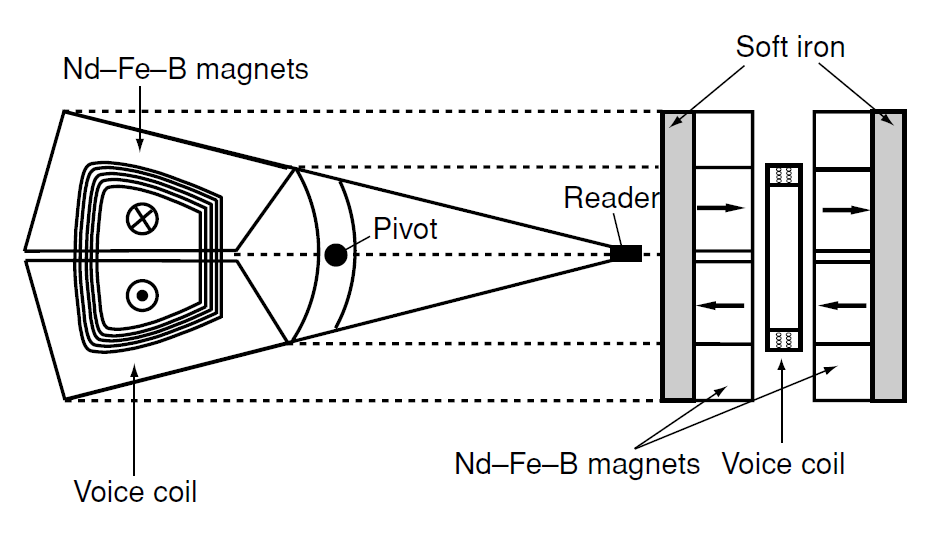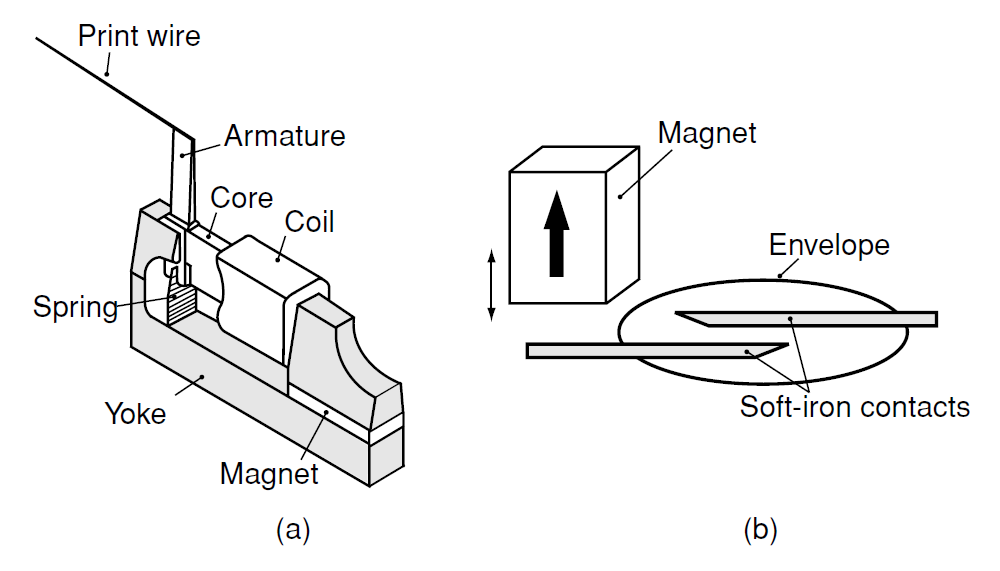


 الفيزياء الكلاسيكية
الفيزياء الكلاسيكية
 الكهربائية والمغناطيسية
الكهربائية والمغناطيسية
 علم البصريات
علم البصريات
 الفيزياء الحديثة
الفيزياء الحديثة
 النظرية النسبية
النظرية النسبية
 الفيزياء النووية
الفيزياء النووية
 فيزياء الحالة الصلبة
فيزياء الحالة الصلبة
 الليزر
الليزر
 علم الفلك
علم الفلك
 المجموعة الشمسية
المجموعة الشمسية
 الطاقة البديلة
الطاقة البديلة
 الفيزياء والعلوم الأخرى
الفيزياء والعلوم الأخرى
 مواضيع عامة في الفيزياء
مواضيع عامة في الفيزياء|
Read More
Date: 16-2-2021
Date: 8-3-2021
Date: 5-3-2021
|
Actuators
An actuator is a electromechanical device with a limited linear or angular displacement. Usually, the airgap is fixed, and the dynamic working is due to the H-field produced by current windings. Three basic configurations are moving-coil, moving-magnet and moving-iron.
Moving-coil loudspeakers have been built with permanent magnets for about a century. Flux is directed into a radial airgap where the voice coil is suspended, attatched to a light, rigid cone. As the current passes through the coil, the force on it is proportional to Bg. The coil moves, vibrating the cone, which produces sound. Acoustic power Pv varies as B2g .This is maximized by operating at the (BH)max point. Large, flat ferrite ring magnets can be used with iron to concentrate the flux . These designs are cheap but inefficient because there is much flux leakage; the flux loss factor β ≈ 0.4.
Stray fields are reduced in the cylindrical magnet designs using alnico or rareearth magnets. Moving-magnet designs are feasible using Nd2Fe14B, where the magnet is glued to the cone and a stationary drive-coil surrounds it. Voice-coil actuators are essentially similar to loudspeakers in design. They are used for head positioning in computer hard-disc drives and mirror positioning in laser scanners. Rapid dynamic response is ensured by the low mass of the voice-coil assembly and the low inductance of the coil in the airgap. With a cylindrical coil, radially magnetized ring magnets can be used to enhance the flux density in the airgap.
A flat-coil configuration where the coil is attatched to a lever which allows it to swing in a limited arc between two pairs of rare-earth magnets is the favoured design for the flat disc drives of portable personal computers, Fig. 1. Nd–Fe–B with the highest possible energy product is required

Figure 1: A flat voice-coil actuator for a personal-computer disc drive.
(>400 kJ m−3). Access time at constant acceleration a is proportional to a−1/2, hence to B−1/2g , since the force f = BgI l = ma.
Moving-coil meters are rotating-coil actuators with no stringent dynamic response requirement, but very uniformairgap flux density is needed to achieve a deflection which is accurately proportional to current. The requirement for minimal temperature variation of the flux density leads to the choice of alnico magnets.
Moving-magnet actuators may be linear or rotating. They offer low inertia and no flying leads. Linear reciprocating actuators with a stroke of several millimetres are used in pumps at frequencies of order 50 Hz. The mechanical system is designed to operate at its resonant frequency. Rotary actuators can be regarded as reversible electric motors with restricted travel.
Moving-iron actuators may also be linear or rotary. A design that was used for a print hammer in a dot-matrix printer is shown in Fig. 2(a). The hammer spring forms part of the magnetic circuit, and in the unexcited position it is held tight against the iron, with no airgap. When a current pulse passes through the solenoid, the hammer springs out. A similar principle is used in reed switches, where two flat soft-iron reeds are drawn into contact by a magnetic field (Fig. 2(b)). The switch can be opened by activating a solenoid to create a reverse field, or simply by moving the magnet.

Figure 2: Moving-iron actuators: (a) print hammer and (b) reed switch.



|
|
|
|
دخلت غرفة فنسيت ماذا تريد من داخلها.. خبير يفسر الحالة
|
|
|
|
|
|
|
ثورة طبية.. ابتكار أصغر جهاز لتنظيم ضربات القلب في العالم
|
|
|
|
|
|
|
سماحة السيد الصافي يؤكد ضرورة تعريف المجتمعات بأهمية مبادئ أهل البيت (عليهم السلام) في إيجاد حلول للمشاكل الاجتماعية
|
|
|